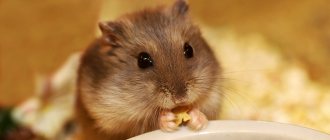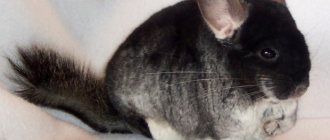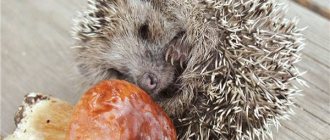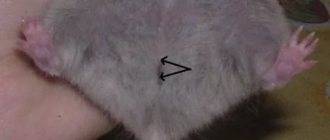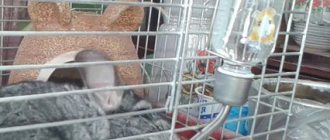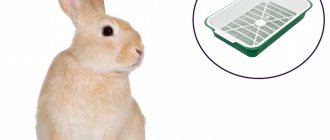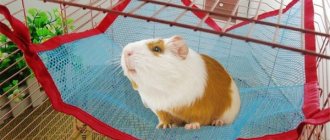Determining the sex of the Djungarian hamster is necessary in order to choose the right name for the pet and get the opportunity to start breeding these rodents. This can be done by the appearance, behavior and genitals of the animal.
Let's find out at what age it is easier to distinguish a boy from a girl, and which method of determining gender is the most reliable.
Preparing a rodent for examination
Choose a time when the dwarf is calm or sleepy. At this point, he will be less aggressive and will not try to break free. Be sure to pet, caress, and give your pet a tasty treat.
Place the jungarik in your left palm. Then, using the thumb and index finger on your right hand, gently grab the fold of skin between your shoulder blades. This will help secure the rodent so that it does not spin around and bite its owner. Pulling the skin and lifting the pet in this position is prohibited. Carefully turn the animal onto its back. It is ready for inspection.
How to properly hold a pet
To avoid causing damage, you need to know how to properly hold your pet during the examination:
- Lift your pet by the front legs, lightly squeezing it with your index and thumb.
- The back part is held with the other hand.
- A second person examines the animal or takes a photograph to make the procedure go faster.
Hamsters should not be picked up by the scruff of the neck, turned over on their backs or upside down, because it brings them pain and discomfort.
Gently hold the hamster.
Distinctive features of a female from a male
The color and muzzle are the same for all individuals. Djungarian hamsters have a dark stripe along their spine. This dwarf rodent grows up to 10 cm and weighs 35–65 g, has a short tail, which is practically hidden from prying eyes when the animal sits down. Wool covers not only the animal's body, but also its feet. The dominant color of the fur is often diluted with noticeable white patches.
The peculiarity of males is the presence of a male gland. It is located on the tummy, similar in appearance to the navel, sometimes there may be yellow droplets of secretion on it that smell. Its function is to mark territory. Girls do not have it.
The genital organ is located at a distance of 0.5–1 cm from the anus. In the abdominal area, fur is observed.
In females, the vagina is located closer to the anus. There is no hair in the genital area, and nipples can be seen on the abdomen.
Appearance
There are minor visual differences between a girl and a boy that are not immediately noticeable.
Females are larger compared to males. If the owner has more than one animal, it is easy to notice.
The Djungarian hamster has short hair, so it is not difficult to detect the navel in girls. Males look different: their coat is long and thick, especially in the genital area.
Behavior
Girls are more active compared to boys. Males are characterized as calm and balanced animals, spending most of their time in a sleepy state. Naturally, they love to play, but not as often as girls.
Boys can only be aggressive towards a conspecific of the same sex during mating. In relation to the owner, they are patient and easier to make contact than girls.
Sex differences: summary
To determine the sex of adult jungarians, you need to consider the following points:
- Females are larger than males, and their backs are of different shapes.
- The genitals are clearly visible in adult pets. Boys have well-convex almond-shaped testicles, this is especially visible if you put a little pressure on the tummy.
- Girls have nipples. When carefully moving along the animal's abdomen, they can be felt in the amount of 8 pieces.
- In male Djungarians, you can notice an odorous gland near the navel.
Brief characteristics of dzhungariks
Not always sellers in a pet store and even breeders (especially those without experience in breeding animals) are trained to recognize male and female individuals . It happens that the seller of hamsters deliberately misleads in order to sell “stale” or substandard live goods. In both cases, you will need basic knowledge of the location and structure of hamster reproductive organs.
First. Perhaps you have set a specific goal - to buy only a boy or a girl. Here, a person who intends to acquire a male Djungarian falls into a special risk zone. To an amateur in matters of sexual dimorphism, you can sell a female, and the fact that you have been fooled will become clear after two to three weeks, when the “boy” gives birth to numerous offspring. And then, instead of one pet, you will be forced to care for 5-6 dwarf hamsters: feed them, clean up after them and sort the growing babies into different cages.
Second. The ability to navigate the anatomical nuances of dwarf hamsters will help those who decide to start a modest business - breeding dwarf hamsters. If you ignorantly buy a pair of same-sex rodents, they will not only not produce offspring, but will simply mutilate each other.
Important ! Djungarian hamsters are highly territorial animals that do not tolerate any competitors near them. This rule applies to all same-sex individuals who have reached reproductive age: this is why young Djungarians from the same litter must be seated on time.
Third. If you do not have entrepreneurial acumen, and you have only one hamster and plays the role of your spiritual friend, in this case, awareness of its gender will be needed to choose a nickname. Of course, you can choose a name from the “unisex” category (Valya, Zhenya or Shura), but aren’t you interested in who will live next to you for several years?
Determining the sex of small hamsters
These signs are best visible already in two-month-old individuals, but in general, obvious characteristics are visible after 4 weeks. It is impossible to determine the gender of a newborn baby.
If you look closely at the butt of small hamsters, you will notice two small round spots, raised at the edges, of a pink hue. This is the anus and urinary opening.
By the gap between you can determine the gender of the baby. In females they are located very close, sometimes it may seem that there is only one hole, but this is not the case at all. In boys, the anal passage is located directly under the tail, and the hole for urine removal is on the abdomen closer to the center. In the genital area you can find a round “swelling” - this is the development of the testes.
The most common mistake is the desire to see if the animal has testicles. Thanks to this approach, the owner often makes the wrong conclusion, since Djungarian hamsters have quite small genitals. In babies, they have not yet fully formed, and sometimes even in a sexually mature male, the testes do not descend into the scrotum, but are hidden in the abdominal cavity.
If the testicles can be easily seen, then there can be no mistake in determining the sex of the Djungarian hamster - this is a boy. An almond-shaped rounded formation in the pet’s genital area can be noticed 6 weeks after the birth of the rodent. With age, the testes become larger, and gender can be determined without difficulty.
At what age is it easier to recognize
The sex of small hamsters is almost impossible to determine. It becomes real at 4 weeks. However, at this age, experts do not recommend separating cubs from their parents or even handling them at all.
During the first month, it is important to ensure normal development of hamsters so that they get used to an active lifestyle. To make it easier to determine the sex of your pet later, it is important to avoid its obesity in the first weeks of life. In order for a hamster to expend all its energy, it must run several kilometers a day.
The settlement of babies should be done at 35-40 days. At this time, it is necessary to determine the sex of the rodents. If you do not plan to breed hamsters in the future, it is worth separating the males from the females. Same-sex animals are allowed to be kept in the same cage. However, these animals largely prefer a solitary existence. Therefore, it is better to place them in individual dwellings.
In addition, every hamster needs a certain space. Therefore, a small cage cannot be used to house 5 individuals at the same time.
METHODS OF DETERMINATION
There are several methods to determine the sex of a Djungarian hamster.
The sex of a hamster can be determined when the animal reaches three to four weeks of age. If the hamster is already an adult, there should be no problems with sex determination. But if puberty has not yet occurred, it is worth trying the following methods.
First you need to secure the hamster. two ways to do this .
- We need the hamster to spread its hind legs and let us see its genitals. To do this, with clean hands, carefully grab it by the scruff of the neck and lift it, the hamster will stretch out, and it will be easier to establish its sex.
- The second method is much preferable because it causes less anxiety and discomfort to the animal. So, you can place the hamster on your palm with its belly up and hold it with your thumb. Under no circumstances should you squeeze the body of your cute rodent too tightly; you need to handle it very carefully, identifying the animal’s sexual characteristics with your free hand. Stroke the hamster's belly a little to calm it down, caress it, because with caress you can achieve much more from an animal. And the pet will know that you can be trusted and you will not harm him.
You can read how the ampularia snail lives at home, care and maintenance, nutrition.
From here you will learn how to establish contact with a pet hamster and tame it.
Recommendations for bathing a hamster and the features of keeping your pet clean are described here.
Care and maintenance at home
When choosing a cage for a Djungarian hamster, it is worth remembering that although the rodent is small, it must have its own territory.
The cage should not be less than 50*30 cm in size along the bottom. It has been noted that hamsters living in small cages often suffer from limb failure. The height of the cage for dwarfs is not so important. However, high walls can be dangerous, as rodents like to climb up the bars to the very roof and fall from there. Multi-storey cages and lattice staircases are also dangerous. They are very dangerous, besides, they conduct oxygen poorly and are difficult to wash.
Instead of a standard classic cage, you can use:
- The food container is the right size. At the same time, you should not make ventilation on the walls, since a rodent can easily catch its teeth on a hole, chew it and escape. Therefore, a hole is made in the lid of the container, and a metal mesh is attached to it. This is a very convenient option for those who have cats at home, since they will not be able to get to the rodent.
- "Dune". This is a cage that has plastic transparent walls; it closes at the top. Very convenient, but has a decent price.
- Rack. Made from glass and wood. It looks very nice in the interior, is reliable and easy to clean.
To fill the cage you can use:
- Fruit tree sawdust. You cannot use pine needles for bedding, as they cause respiratory problems and allergies in hamsters.
- Corn filler. It is considered one of the most convenient and functional. However, it is not so easy to find in pet stores.
- Cellulose filler. Also very practical and pleasant for the hamster. You can do it yourself. You can use regular undyed table napkins for this. They need to be torn into small pieces and put into the cage.
The cage must have a wheel of the appropriate size. You can't put it away at night to avoid noise. The domestic Djungarian hamster is a nocturnal animal, and its peak activity occurs in the late evening and early morning. The diameter of the wheel must be at least 16 cm. A smaller wheel can lead to curvature of the rodent's spine, which can later cause failure of the hind limbs.
The cage should have a house in which the hamster can hide and sleep during the day. It is best to take a house without large round windows. It happened that, having stuffed food into their cheeks, hamsters got stuck when they tried to crawl through the window. Such an incident could well lead to the death of the animal. You can add fruit tree sticks to the cage, with the help of which the rodent will grind down its teeth.
Various tunnels and swings will entertain the rodent and help sharpen its claws. A hamster should not be bathed in water. For hygiene procedures, you can use sand for chinchillas. It should be poured into a shallow container and placed in a cage. Hamsters love to bathe in sand, but sometimes they can use the bath as a toilet. In this case, sand should not be left in the cage all the time.
Do not put fabric, cotton wool or hay in the cage. It often happens that the long fibers put pressure on the hamster's paw, causing it to die. After this, the rodent gnaws off its damaged limb. You can put a toilet in the corner of the cage. Hamsters often relieve themselves in one place, which makes cleaning easier.
Health
Their health and life expectancy depend on how well the care and maintenance of Djungarian hamsters is organized. These small rodents are susceptible to viral and bacterial infections, parasite attacks and skin diseases, and they often develop tumors. Among the latter, eczema is the most common. Also, a pet that runs a lot is often injured.
Each disease is expressed by certain symptoms. If your pet is constantly itching, then most likely there are parasites in its coat. The presence of viral diseases is indicated by apathy, sneezing and lack of appetite. When injured, rodents practically do not move. If a dwarf has injured his teeth, he will refuse to eat, and if he has eaten something stale, he will have diarrhea.
You should not treat your furry friend on your own. If you see that something is happening to the dwarf, go to the vet immediately. If your pet falls, inspect it immediately.
We have covered everything about Djungarian hamsters. If we talk about disadvantages, it is difficult to find disadvantages in representatives of this breed. Owners can only complain about the noise their pets make at night. In general, keeping small pets is not tiresome for owners.
Simple wire cutters
The most primitive device is very similar to ordinary scissors. Only one of its cutting surfaces is equipped with a small notch with a sharp edge. Using such a device is easy, provided you have some skill and experience. For young dogs, nail trimming is always stressful. They do not want to sit quietly, they strive to tear the paw out of the owner’s hands and in every possible way complicate the process. So Litbro.ru will not recommend such a gadget to novice dog breeders. The risk of causing serious physical injury to your pet is too great. Well, for experienced owners who have used similar tools more than once, nothing better can be desired. Cheap and very effective.
Cost – 35 – 72 rubles.
More advanced versions of hand cutters offer expanded functionality.
Although their main part, in the old fashioned way, is based on two cutting surfaces. Service additions imply only human convenience. Models with rounded ends, a container for cut claws and lighting have proven themselves very well. The fact is that some dogs have the habit of looking for clipped ends on the floor and eating them. Sharp, bent cuttings can damage the stomach wall and cause bleeding. A small “waste collection” effectively solves this problem.
Price – 636 rub.
Another gadget from the line of simple nippers has comfortable ergonomic handles that allow you to securely hold the tool while trimming nails.
This is important when the animal gets nervous and breaks out.
We pay attention to one more detail - the expansion spring. It fixes the cutting surfaces in the open state, which makes the operation somewhat easier.
Otherwise, the functions of the device duplicate all the features of its predecessors. To properly shorten claws, you must have the skill and achieve unquestioning obedience from your dog or cat.
Cost – 229.93 rubles.
How to calm your pet correctly
During the examination, the hamster may worry and squirm. If your pet is very nervous, then it is best to put him back in the cage and wait until he calms down.
If the examination was still possible, then after the procedure it is necessary to give the animal a treat and lightly pat it on the back to relieve tension.
Give the animal a treat to calm it down.
Interesting facts about hamsters
- Although the animal is a herbivorous rodent, its diet can include all kinds of insects. This gives the body additional protein.
- In North America, forest hamsters act like magpies - they carry shiny things into their burrows. But in place of the stolen item, they almost always leave a pebble or a twig, as if exchanging. But in reality, everything is simpler - the animal simply throws what it was carrying in order to grab the sparkling thing.
- The cheek pouches can hold an amount of food equal to a fifth of the animal's weight.
- Hamsters are born with teeth, which continue to grow throughout their lives, being worn down by gnawing. The teeth of guinea pigs are similar.
- The animals are quite smart. They are trainable and usually easily remember their name and the faces of those in their household.
- Most domestic golden hamsters come from a single female, who gave birth to twelve babies in 1930.
- If we convert the age of these animals to human ones, then one year is equal to 25 human years.
- During long runs, the animals mark their path with the help of scent glands.
- The animal does not see very well, and also does not distinguish colors, but it has a well-developed sense of smell and hearing.
- This feature has been noticed in dwarf hamsters - the female can delay the birth of a new litter while she feeds the previous one, this happens both at home and in the wild.
- In science, cells extracted from the ovaries of Chinese hamsters are used in the production of many drugs for serious diseases, in particular multiple sclerosis and chronic lymphocytic leukemia.
- In Vietnam, keeping these animals at home is prohibited by law because they carry infectious diseases.
- Newton's and Syrian hamsters are listed in the Red Book and are on the verge of extinction in the wild.
- Food reserves can reach 90 kg. Like squirrels, hamsters store much more than they can eat.
- As a rule, only one animal lives in each large branched burrow.
- Hamsters are good swimmers - they have adapted to draw air into their cheek pouches, creating something like a float.
- The name of the animal originates from the ancient Avestan dialect and roughly translates as “enemy pressing in the ground” due to the habit of the animals bending plant stems in the ground to get food.
Hamster 4.3 (85.26%) votes: 38

